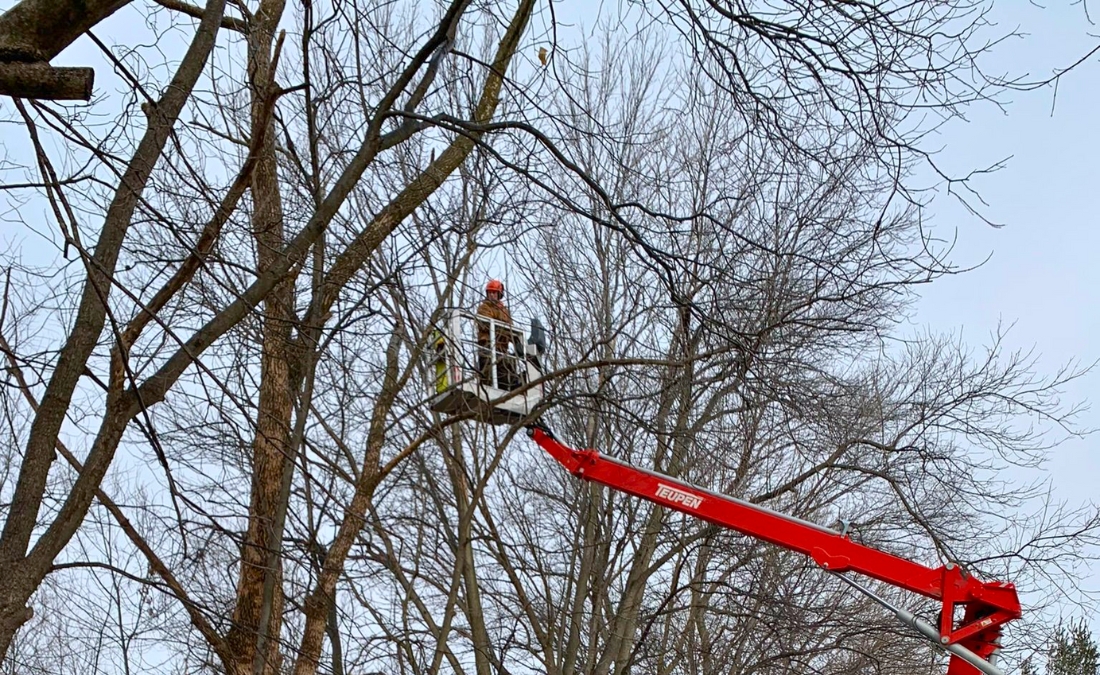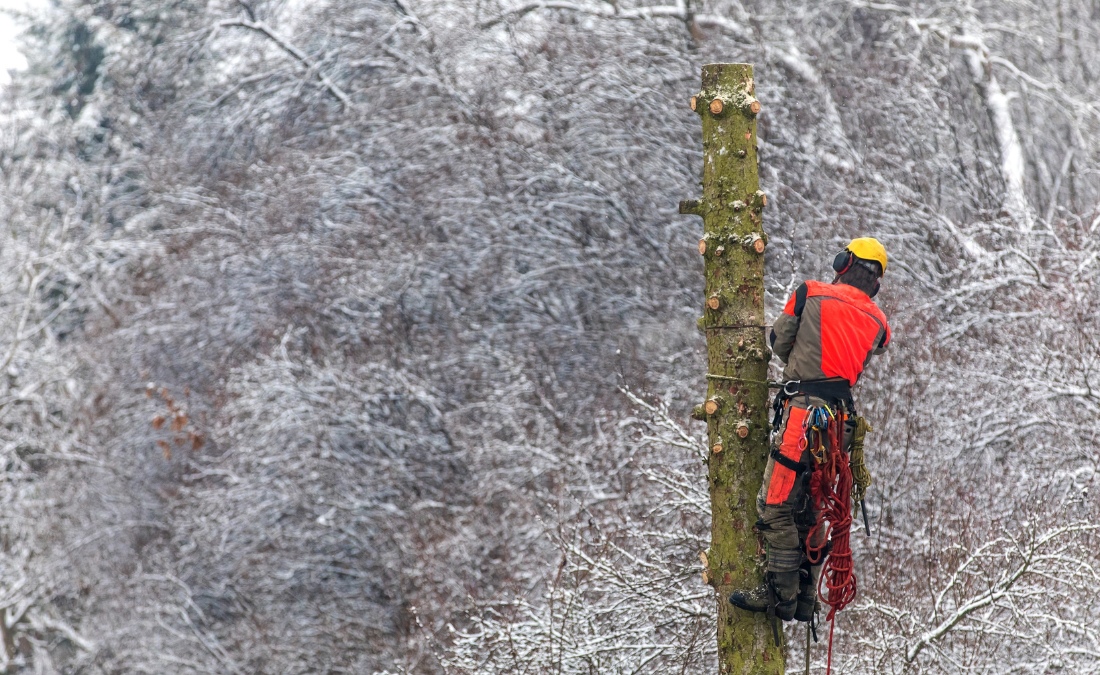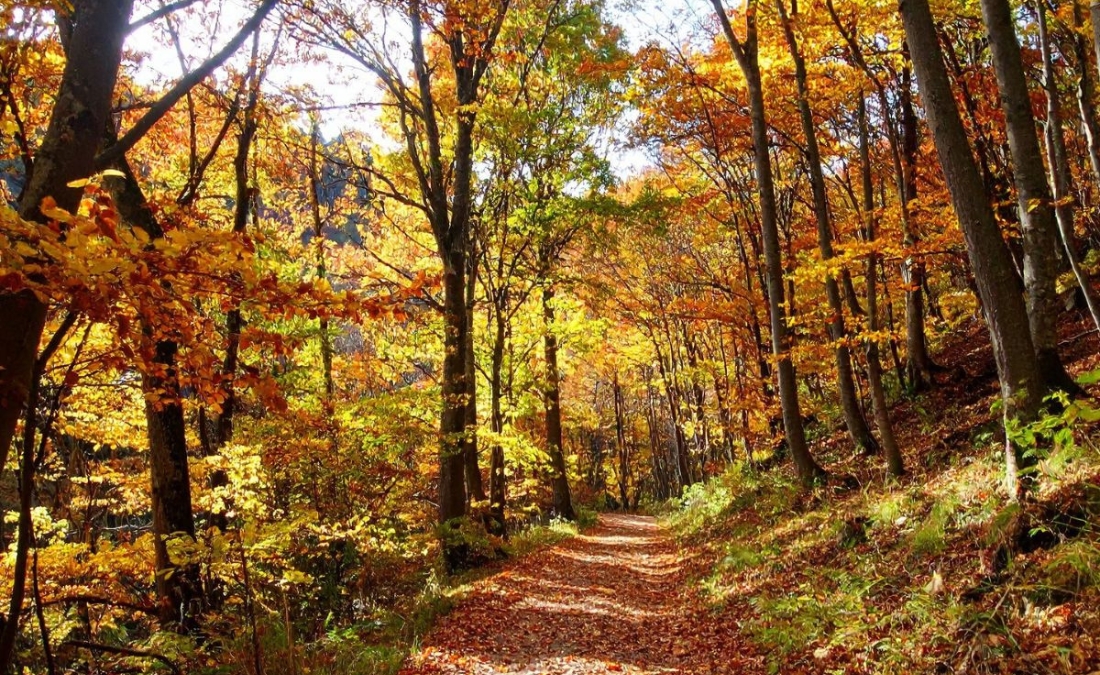Spotting and Fixing Dangerous Girdling Roots Before They Strangle Your Trees
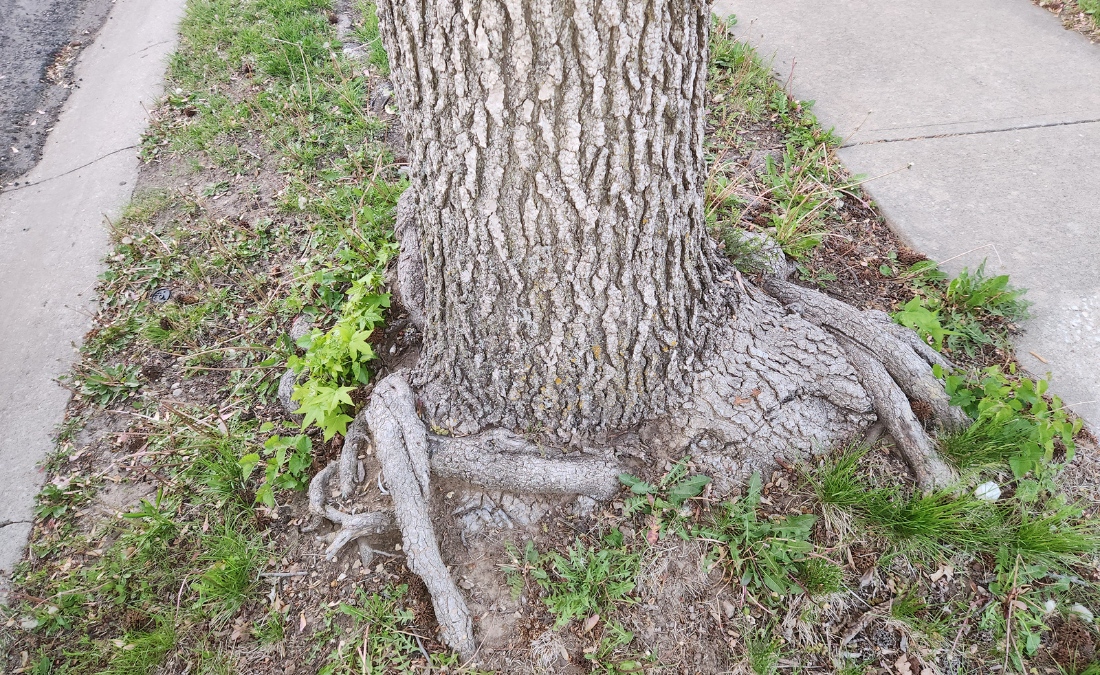
Girdling roots in Des Moines can silently kill mature trees. Learn how to spot early signs, best treatment timing, and when removal is the safer choice.
Mature trees throughout Des Moines’ established neighborhoods face a hidden threat that develops slowly over decades. Thick roots circling around the trunk base compress vascular tissue and gradually cut off the flow of water and nutrients. These girdling roots are surprisingly common on the sugar maples, oaks, and American elms that line streets in Beaverdale, Greenwood Historic, and Drake.
Left untreated, girdling roots kill Des Moines trees over time. However, early detection combined with professional treatment can save even severely affected trees. That’s why it is so important to recognize the visual symptoms and understand why ISA Certified Arborists are essential for safe treatment that protects valuable landscape investments.
Key Takeaways
- Girdling roots develop when roots circle or grow across the trunk, compressing vascular tissue and slowly strangling mature trees common in Beaverdale, Greenwood Park Plats, Drake, and other Des Moines area neighborhoods.
- There are 6 visual symptoms that help homeowners identify the problem early: a buried root flare, visible circling roots, premature fall color, thinning canopy, stunted growth, and unexplained tree lean.
- Sugar maple, oak, hackberry, and American elm trees that line Des Moines’ established streets are particularly susceptible to girdling root development.
- Professional air spading safely exposes the root system without damage, allowing ISA Certified Arborists to assess which roots can be removed and which must remain for tree stability.
- Iowa’s dormant season from late fall through early spring provides the optimal treatment window when trees experience minimal stress from root pruning.
- Recovery takes 2 to 3 growing seasons, but successfully treated trees regain vigor with fuller canopies, better leaf color, and improved overall health.
What Are Girdling Roots?
Girdling roots are roots that wrap fully or partially around a tree’s trunk, either above ground where they’re visible or just below the soil surface, where they remain hidden for years. As both the root and trunk grow larger in diameter, they create a compression zone that disrupts the tree’s vascular system.
Girdling roots act like a tightening belt, squeezing the tree a little more each year. This pressure blocks circulation, restricting water and nutrients can’t move upward through the xylem, and carbohydrates can’t move downward through the phloem. Over time, the tree slowly starves itself.
Expert Insight: “When roots are buried too deep or the soil grade changes, trees respond by sending out new surface roots. Instead of growing outward, these adventitious roots often wrap around the trunk or other roots, slowly choking off the tree’s ability to move water and nutrients to the canopy. That’s why those trees are often the first to show early fall color or thin foliage. The solution is to expose the root flare and carefully remove the problem roots. It can stress the tree in the short term, but leaving girdling roots untreated is almost always fatal in urban settings.” – Stephen Carlson, Director of Sales at Arbor Masters
What Causes Girdling Roots?
Girdling roots in Des Moines trees usually develop from planting and growing conditions that restrict normal root spread. Several common factors contribute to the problem:
Container-Grown Nursery Stock
Trees that spend too long in nursery containers develop roots that circle the inside of the pot because they have nowhere else to grow. When these circling roots aren’t cut or loosened at planting time, they continue that circular pattern in the ground. This is the most common cause of girdling roots.
Improper Planting Depth
Many mature trees in Greenwood Park Plats and Beaverdale were planted 50 to 70 years ago, when proper planting depth wasn’t well understood. Trees planted too deep often develop girdling roots as they attempt to establish a proper root system closer to the surface.
Soil Compaction
High-traffic areas, like Valley Junction, experience significant pedestrian activity around street trees. This compacts the soil and limits where roots can grow, forcing them into circular patterns as they search for paths of least resistance.
Buried Root Flare
When additional soil is added around established trees, it buries the root flare. The tree responds by sending out new adventitious roots (roots that grow from the trunk rather than from the existing root system) from the buried trunk tissue. These new roots often circle back toward the trunk instead of growing outward.
Girdling roots develop slowly over many years, with some trees declining gradually over decades while others fail suddenly during storms when the compressed trunk creates a structural weak point.
6 Clear Signs Your Tree Has Girdling Roots
You don’t need to be a professional arborist to recognize the warning signs of girdling roots. Here are six symptoms you can identify from examining your own trees.
1. Missing or Reduced Root Flare at Trunk Base
A healthy tree trunk widens where it meets the soil, creating a smooth transition from trunk to roots known as the root flare. This flare should be visible all the way around the tree.
If the trunk appears to go straight into the ground with no visible widening, that’s a warning sign. Walk around the tree and check from every side; sometimes girdling roots or soil buildup only hide the flare on one side, while the other sides look normal.
In Des Moines neighborhoods, like Beaverdale, where many mature street trees were planted too deep decades ago, it’s common to see trunks buried past the flare. These hidden or compressed flares often signal underlying girdling root problems that threaten the long-term health of the tree.
2. Visible Roots Circling the Trunk Above or Just Below Soil
Sometimes girdling roots are obvious. You’ll see thick roots crossing horizontally over the trunk or circling around it. These may be fully exposed or only partially visible, with most of the problem hidden just beneath the soil surface.
Don’t assume that just because you see one circling root, that’s the full extent of the problem. Usually, visible girdling roots indicate more roots circling below ground where you can’t see them.
The century-old trees throughout Greenwood Park Plats Historic neighborhood, for instance, often display this symptom as soil erodes away over time, gradually exposing what was hidden for decades. As a National Register Historic District, Greenwood’s mature tree canopy is an integral part of the neighborhood’s character and historic value, making preservation of these specimens particularly important.
3. Early Fall Color or Premature Leaf Drop
If you notice maples in neighborhoods, like Drake, turning brilliant red or orange and dropping leaves in late August while nearby trees are still green, that’s a red flag. Early color change is often a stress response, not a sign of extra or premature beauty.
Trees with girdling roots can’t move enough water and nutrients to the canopy, so they conserve energy by shutting down early and dropping leaves weeks ahead of schedule.
Other warning signs include foliage that’s pale green or leaves with scorched, brown edges – especially when healthy maples nearby look normal.
4. Thinning Canopy or “10-2 o’clock” Dieback Pattern
If you notice that your tree’s crown is exceptionally sparse and thin, especially compared to neighboring trees of similar age and species, girdling roots could be the culprit.
Girdling roots often cause dieback to occur first in the upper portion of the canopy, typically in the area between 10 and 2 o’clock if you imagine the crown as a clock face. This pattern occurs because the upper canopy is furthest from the compromised root system and most vulnerable to resource shortages.
The mature oaks in Westridge, for instance, show this symptom clearly when affected. Instead of the full, dense canopy that oaks are known for, trees with girdling roots develop an increasingly sparse appearance over several years.
5. Stunted Growth or Smaller Leaves Than Normal
Compare your tree to others of the same species on your block. Are the leaves noticeably smaller? Do new shoots show less growth each year?
Girdling roots restrict the flow of carbohydrates produced by leaves back down to the roots for storage, creating an energy imbalance that manifests as reduced growth and smaller foliage.
Northern Hackberry trees, common throughout all Des Moines neighborhoods, particularly show this symptom when dealing with girdling roots. The difference in leaf size between affected and healthy trees becomes quite obvious once you know to look for it.
6. New Tree Leaning or Instability
A tree that begins leaning without any recent storm damage may be suffering from structural instability as a result of girdling roots. When roots wrap all the way around the trunk, they create a pressure point that weakens the tree’s structure. Over time, this stress can cause the tree to lean or even topple during ordinary winds.
This is particularly concerning from a safety standpoint. If a tree has severe girdling roots that have gone unnoticed, even a perfectly healthy-looking tree can collapse without warning in moderate weather.
Especially in pedestrian-heavy areas, like Valley Junction, where mature trees line sidewalks near shops and cafes, posing risks to both property and public safety.
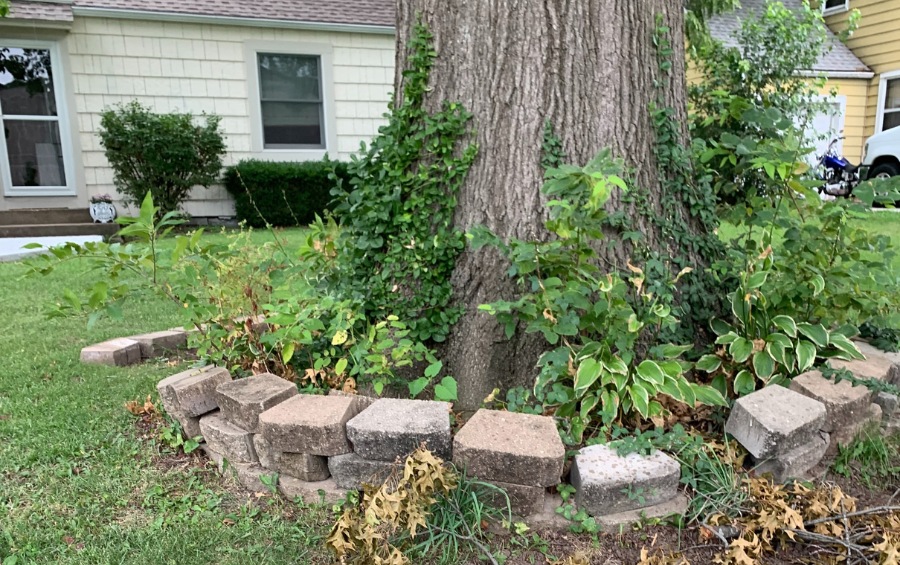
Raised soil and block edging cover the natural root flare of this tree. These conditions conceal hidden girdling roots that will stress the tree over time.
Why Sugar Maples, Oaks, and Hackberry Trees in Des Moines Are Most at Risk
Not all tree species are equally prone to girdling roots. The way a tree grows – its root structure, growth rate, and sensitivity to soil conditions – all play a big role in whether this problem develops.
In Des Moines’ established neighborhoods, species like sugar maples, oaks, and hackberries are especially vulnerable. These long-lived shade trees were widely planted decades ago for their beauty and resilience, but their age, planting practices, and root tendencies make them more susceptible to girdling root issues today.
Sugar Maples (Acer saccharum)
Sugar maples, common along Beaverdale’s brick-lined streets, are highly prone to girdling roots. Their shallow, fibrous root systems often circle in containers or when planted too deep, making them especially vulnerable. In neighborhoods that rely on mature maples for shade and fall color, hidden root problems threaten both tree health and the character of the streetscape.
Oak Species (Quercus)
Red and pin oaks often mask girdling root issues until decline is advanced. Buried root flares encourage roots to wrap the trunk, leading to thinning canopies and premature leaf drop. In Drake, where oak decline already thins the canopy, girdling roots pose added risk, endangering property values tied to mature shade trees near the university.
American Elms (Ulmus americana)
American elms that have survived Dutch elm disease in older Des Moines neighborhoods, like Greenwood Park Plats, are historic and irreplaceable, yet vulnerable to girdling roots. Their rapid early growth and sensitivity to soil compaction can lead to hidden root defects. Symptoms like early yellowing or branch dieback may not appear until decline is advanced, making early detection essential.
Hackberry (Celtis occidentalis)
Hackberries are hardy urban trees but develop girdling roots when planted in compacted soils or confined spaces. Their vigorous roots can press against the trunk, causing uneven canopy growth, leaf scorch, or sudden lean. Because many were planted as elm replacements in established neighborhoods, like West Des Moines, widespread decline threatens the continuity of entire streets.
Linden (Tilia)
Lindens, also known as basswoods, provide dense shade and fragrant blooms but often suffer from girdling roots if planted too deep or grown in containers. With smooth bark and straight trunks, problems are hard to spot early. Symptoms include canopy thinning, leaf scorch, and premature color change, reducing their lifespan in streetscapes and parks.
Des Moines’ mature tree canopy adds beauty, shade, and value to established neighborhoods. City leaders have outlined this priority in the Urban Forest Master Plan, and even developed a forest carbon credit program to recognize the environmental and economic benefits of preserving healthy trees.
In neighborhoods like Westridge and Ashworth, where spacious lots showcase decades-old specimens, investing in professional girdling root treatment helps protect both property value and community character.
How Arborists Treat Girdling Roots: Air Spading and Strategic Root Removal
At Arbor Masters, our ISA Certified Arborists use air spading as the safest and most effective method for exposing and treating girdling roots.
This pneumatic tool uses compressed air blasted through a specialized nozzle to break apart and remove soil without damaging delicate root tissue. The air spade allows careful excavation 6 to 18 inches below grade, fully exposing the root flare and all circling roots. This reveals the complete picture of what’s happening at the trunk base.
Why Air Spading Outperforms Traditional Excavation
The technology is particularly valuable because it’s non-destructive. Traditional excavation with shovels or machinery inevitably damages roots, compounding the stress trees already face. Air spading works precisely, removing only soil while leaving all roots intact for assessment.
After exposing the root system, our arborists evaluate several critical factors:
- How many girdling roots are present?
- How large are they in diameter?
- How deeply are they embedded in the trunk?
- What percentage of the root system do they represent?
- Is the tree healthy enough to survive their removal?
These questions determine our recommendation for treatment or, in severe cases, tree removal and replacement.
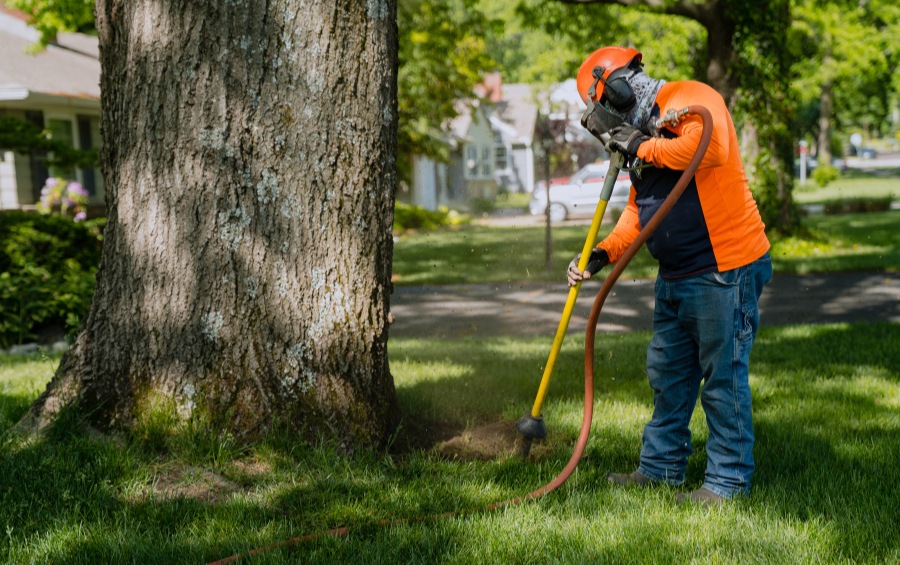
Professional arborists use air spade equipment to expose root systems without cutting into them, making it possible to identify and treat girdling roots safely.
The Risks of DIY Root Cutting
Homeowners sometimes attempt to cut visible girdling roots themselves with a saw or axe. This approach creates several serious problems:
- You can’t assess how much of the root system you’re actually removing: A root that appears to be just a single strand on the surface may actually be supplying water and nutrients to a large portion of the tree’s canopy. Remove it without understanding its role, and rapid decline or death may follow.
- Cutting roots without proper tools and technique introduces decay: Trees naturally compartmentalize wounds when cuts are clean and made correctly. Jagged saw cuts or crushing from improper tools compromise the tree’s ability to seal the wound, creating entry points for rot and disease.
- The visible root may be grafted to the trunk several inches below the soil surface: Pulling on an embedded root can tear away cambium tissue and cause catastrophic damage that isn’t visible until it’s too late.
- Removing multiple large roots without understanding the tree’s stability compromises structural integrity: The tree may be relying on those girdling roots for physical support even as they slowly kill it. Sudden removal can lead to failure during the next windstorm.
Frequently Asked Questions About Girdling Roots in Des Moines
When is the best time to treat girdling roots in Iowa?
The best time to treat girdling roots in Iowa is the dormant season. Late fall (after leaves drop) or early spring (before bud break) helps trees tolerate root loss better because they aren’t actively growing or under heat stress.
What should I expect after girdling root removal?
After root removal, you should expect some stress during the first season, especially symptoms such as smaller leaves or light canopy thinning. Improvement typically shows within 2–3 years with fuller canopies, better leaf color, and stronger growth.
How do I care for my tree after treatment?
After treatment, spread 2–4 inches of mulch around your tree, keeping it a few inches away from the trunk. Watch for wilting, yellowing, or dieback. If the tree’s condition declines instead of improves, contact a certified arborist for follow-up care.
What’s the difference between girdling roots and surface roots that are just exposed?
Surface roots that extend outward from the trunk are normal and only become an issue if they’re damaged by mowing or traffic. Girdling roots, on the other hand, wrap around or press against the trunk, cutting off circulation and leading to long-term decline.
Can mulch volcanoes cause girdling roots to develop on healthy trees?
Yes, mulch volcanoes can cause girdling roots. When mulch is piled high against a tree trunk it keeps the trunk tissue moist and encourages the development of adventitious roots. These new roots grow from the buried trunk tissue rather than from the proper root system, often growing in circular or crossing patterns that lead to girdling.
Are newly planted trees at risk for girdling roots or just older trees?
Both young and older trees are at risk. Newly planted container trees often arrive with circling roots that, if not corrected at planting, keep growing around the trunk. Unfortunately, symptoms usually don’t show until the tree is 15–30 years old, when the roots are large enough to cause visible damage. That’s why proper planting (cutting circling roots and setting the root flare at the right depth) is the best prevention.
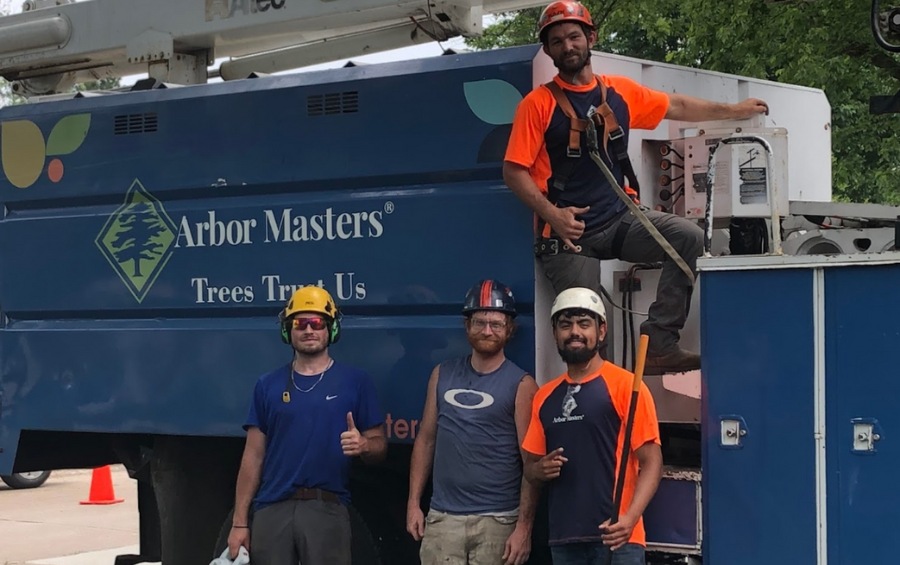
Protect Your Trees from Girdling Roots in Des Moines With Arbor Masters
Girdling roots could be the silent cause of your beloved tree’s decline, making overall tree health awareness and prompt intervention critical. Early detection combined with professional air spading treatment can save even heavily affected trees.
At Arbor Masters, our ISA Certified Arborists have over 60 years of experience preserving mature trees throughout the Des Moines area. We use air spading technology to safely expose and treat girdling roots, giving trees the best chance at long-term health and survival.
Call 515-218-2025 to schedule a free consultation or request an estimate online to get started today.

Get the latest local news, tree care tips, special offers, and company updates directly to your inbox! It's easy to subscribe and there's no spam - we promise.
"*" indicates required fields

